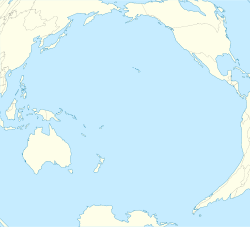| Derwent Hunter Guyot | |
|---|---|
 | |
| Summit depth | 323 metres (1,060 ft) |
| Location | |
| Location | To the east of the coast of New South Wales, Australia |
| Group | Tasmantid Seamount Chain |
| Coordinates | 30°51′57″S 156°11′21″E / 30.86583°S 156.18917°E / -30.86583; 156.18917 |
| Geology | |
| Type | Guyot |
| History | |
| Discovery date | Named from the Australian schooner "Derwent Hunter" that discovered it in 1958 |
The Derwent Hunter Guyot is an extinct volcanic seamount of the Tasmantid Seamount Chain.

It is a basaltic volcano that erupted between 12,400,000 and 15,400,000 years ago, with survey data that indicates it rises about 4,000 m (13,000 ft) above the local sea floor to a minimum depth of 323 m (1,060 ft). The sediments deposited on top of the alkali olivine basalt originate from the early Middle Miocene. The Derwent Hunter Guyot appears to be double peaked. It was discovered in 1958 and described as a seamount in 1961.
The waters above it are incorporated in the Central Eastern Marine Park, an Australian marine park.
References
- ^ "GEBCO Undersea Feature Names Gazetteer".
- ^ Eggins, S. M.; Green, David Headley; Falloon, Trevor J. (1991). "The Tasmantid seamounts: Shallow melting and contamination of an EM1 mantle plume". Earth and Planetary Science Letters. 107 (3–4): 448–462. Bibcode:1991E&PSL.107..448E. doi:10.1016/0012-821X(91)90092-V.
- Quilty, Patrick G. (1993). "Tasmantid and Lord Howe seamounts: biostratigraphy and palaeoceanographic significance". Alcheringa: An Australasian Journal of Palaeontology. 17 (1): 27–53. Bibcode:1993Alch...17...27Q. doi:10.1080/03115519308619487.
- van der Linden, Willem JM (1970). "Morphology of the Tasman Sea floor". New Zealand Journal of Geology and Geophysics. 13 (1): 282–91. Bibcode:1970NZJGG..13..282V. doi:10.1080/00288306.1970.10428218.
- Standard, J. C. (1961). "Submarine Geology of the Tasman Sea". Geological Society of America Bulletin. 72 (12): 1777–1788. doi:10.1130/0016-7606(1961)72[1777:SGOTTS]2.0.CO;2.
- "Temperate East Marine Parks Network Management Plan 2018" (PDF). Parks Australia. Retrieved August 16, 2018.